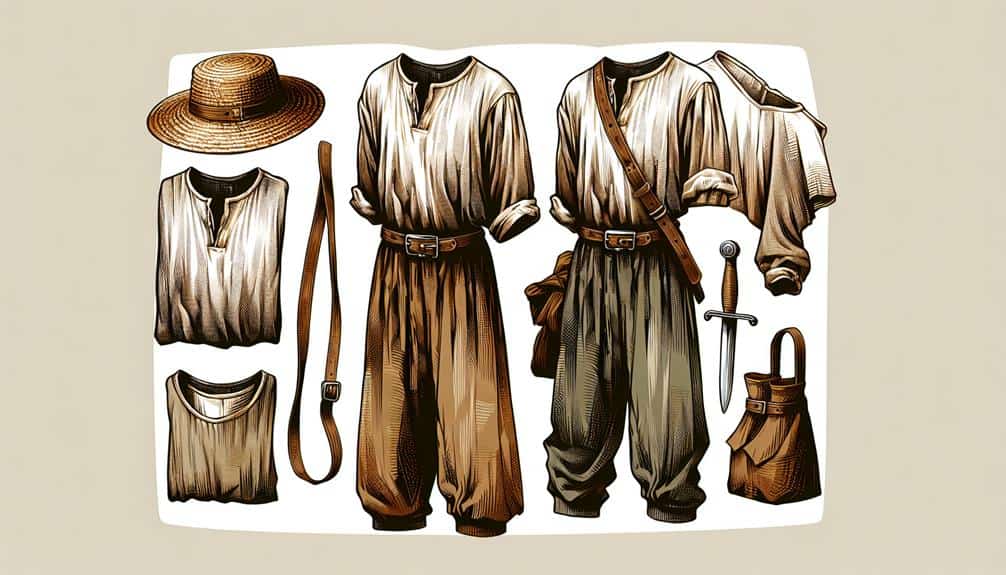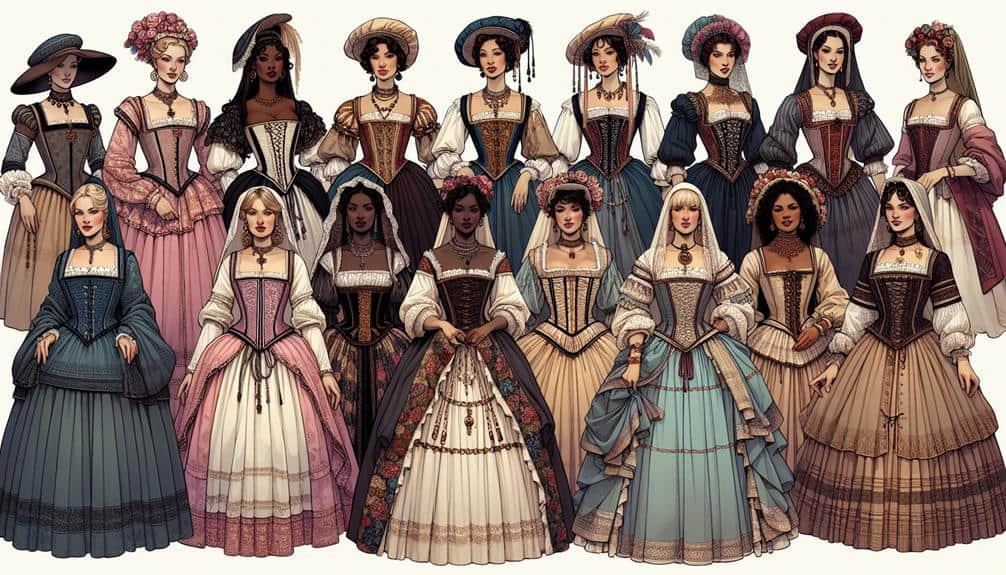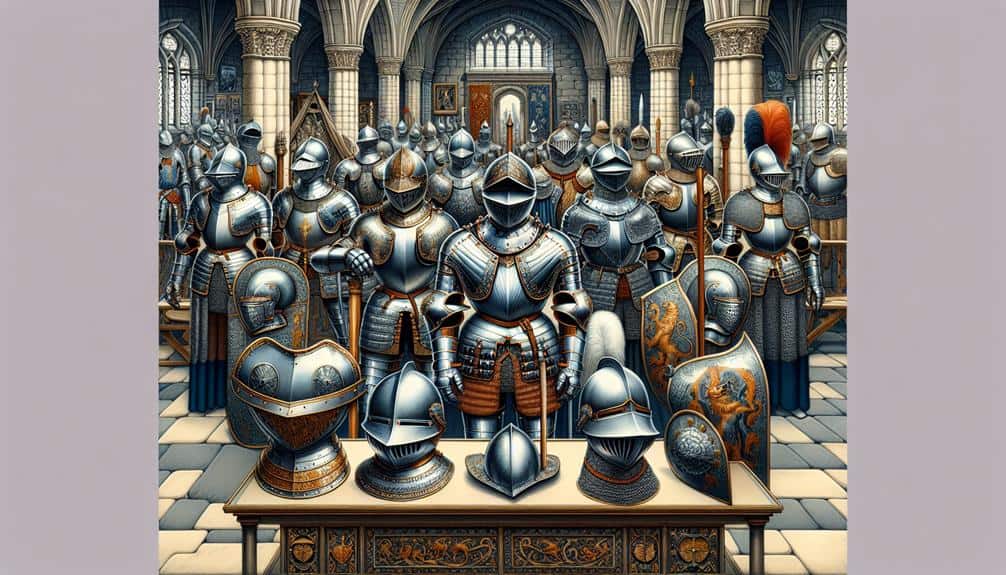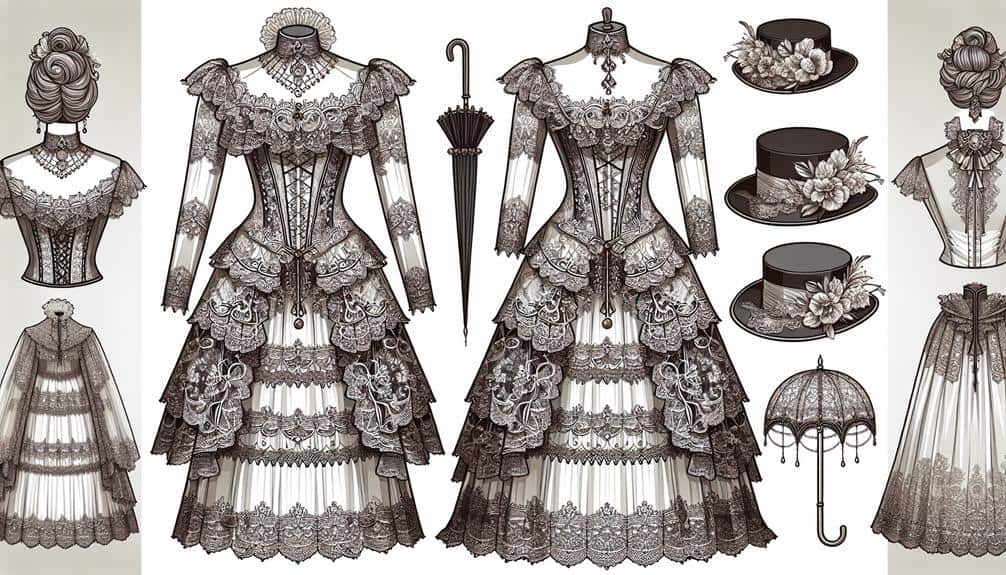If you've ever yearned to transport yourself back in time with the rustic charm of Middle Ages peasant fashion, this guide is tailored just for you.
Discover how to effortlessly recreate the humble yet striking look of a medieval peasant with simple styling tips that will make you stand out at your next themed event.
From choosing the right fabrics to mastering the art of layering, we have everything you need to elevate your costume to the next level.
Key Takeaways
- Opt for rough wool or linen for authenticity and durability.
- Mix textures and earthy tones for visual interest.
- Layer clothing pieces like tunic, breeches, and leather shoes.
- Accessorize with simple items like a leather belt or knitted cap.
Choosing the Right Fabrics
When creating a Middle Ages peasant costume, opt for fabrics such as rough wool or linen for authenticity and durability. These materials were commonly used during that era and will help you achieve historical accuracy in your outfit. Rough wool, in particular, was a staple fabric for peasants due to its affordability and ability to provide warmth in colder seasons. Linen, on the other hand, is lightweight and breathable, making it suitable for warmer weather.
To add visual interest to your peasant costume, consider mixing textures. Combining different fabrics can enhance the overall look and make your outfit more dynamic. For instance, you could pair a rough wool tunic with linen trousers to create a contrast in textures. Additionally, adding accessories like a woven belt or a knitted cap can further elevate your costume.
Essential Peasant Clothing Pieces
For an authentic Middle Ages peasant costume, essential clothing pieces include a tunic, breeches, and sturdy leather shoes. The color palette for these garments would typically consist of earthy tones such as browns, greens, and greys to blend in with the natural surroundings.
When considering authenticity versus comfort, it is indispensable to find a balance between the two. While historical accuracy is vital for a convincing costume, comfort shouldn't be sacrificed entirely. Look for lightweight fabrics that mimic the look of authentic materials like linen or wool while still allowing for breathability and ease of movement.
The tunic should be loose-fitting and reach mid-thigh, often belted at the waist for a more defined silhouette. Breeches should be roomy and gathered at the waist and ankles, providing both comfort and a traditional appearance. Completing the outfit with sturdy leather shoes will enhance the overall authenticity of the costume while ensuring durability for long days of wear.
Layering for Authenticity
To achieve an authentic Middle Ages peasant costume, layering is important for historical accuracy and visual impact. Color coordination plays a significant role in creating a cohesive look. Consider earthy tones like browns, greens, and greys for a historically accurate ensemble. Weather considerations are also essential; opt for breathable fabrics like linen in warmer months and add wool layers for colder weather. Layering not only adds depth to your outfit but also provides practicality in adjusting to changing temperatures.
When layering for authenticity, remember to balance historical accuracy with modern twists. While staying true to the peasant style, feel free to incorporate subtle contemporary elements for a unique touch. Experiment with different textures and lengths to add interest to your layers. Mixing traditional peasant garments with modern pieces can elevate your costume to a more fashionable interpretation without sacrificing historical integrity. By carefully selecting and combining layers with attention to color, weather, and a blend of historical and modern elements, you can achieve an authentic and visually striking Middle Ages peasant costume.
Accessorizing With Simple Techniques
Accessorizing your Middle Ages peasant costume with simple techniques can enhance its overall authenticity and visual appeal.
When selecting accessories, focus on color coordination to achieve a cohesive look. Opt for earthy tones like browns, greens, and muted yellows to capture the rustic charm of the era.
Mix textures such as rough burlap, coarse wool, and simple cotton to add depth and interest to your outfit. Accessories like a leather belt with a brass buckle or a knitted scarf can bring a touch of vintage flair to your costume.
Consider adding a straw hat or a pouch made of rough fabric to complete the ensemble. These small details can make a big difference in the overall authenticity of your Middle Ages peasant costume.
Hair and Makeup Tips
Enhance the authenticity of your Middle Ages peasant costume with carefully chosen hair and makeup techniques that reflect the rustic charm of the era. For your hair, opt for braided hairstyles that were common among medieval peasants. Simple braids or a crown braid can add a touch of historical accuracy to your look. These styles aren't only easy to achieve but also exude a sense of practicality and humility, characteristics associated with peasant life during the Middle Ages.
When it comes to makeup, less is more. Embrace a natural makeup look to complement your peasant costume. Keep your skin looking fresh and dewy with a light foundation or tinted moisturizer. Add a subtle flush to your cheeks with a hint of rosy blush. Enhance your eyes with neutral eyeshadows and a coat of mascara to define your lashes. Finish off the look with a natural lip color or a touch of lip balm for a simple yet charming appearance that aligns perfectly with the humble aesthetic of a medieval peasant.
Frequently Asked Questions
Can You Provide Tips on Where to Find Historically Accurate Peasant Clothing Pieces for a Middle Ages Costume?
You can find historically accurate peasant clothing pieces for a Middle Ages costume at specialty costume shops, online retailers, or even thrift stores. For a DIY touch, add peasant accessories like scarves or belts.
Are There Any Specific Color Palettes or Patterns That Were Common Among Peasants During the Middle Ages?
During the Middle Ages, peasants often wore earthy tones like browns, greens, and muted blues due to the availability of natural dyes. Textile patterns were simple, with stripes, checks, and coarse weaves being common choices for their clothing.
How Can I Make My Peasant Costume More Comfortable for All-Day Wear at a Renaissance Fair or Themed Event?
To make your peasant costume more comfortable for all-day wear at a renaissance fair or themed event, focus on comfortable layers and authentic details. Opt for breathable fabrics and practical accessories to make sure a pleasant experience.
Are There Any Traditional Footwear Options That Would Complement a Middle Ages Peasant Costume?
For your Middle Ages peasant costume, consider traditional footwear like simple leather sandals or sturdy leather boots to complement the look authentically. These choices will add an extra touch of historical accuracy to your ensemble.
What Are Some Common Mistakes to Avoid When Styling a Middle Ages Peasant Costume to Ensure Authenticity?
To guarantee authenticity when styling a Middle Ages peasant costume, avoiding inaccuracies is key. Common mistakes include using modern fabrics, incorrect footwear, and flashy accessories. Stick to earthy tones, simple garments, and basic accessories for a genuine look.



